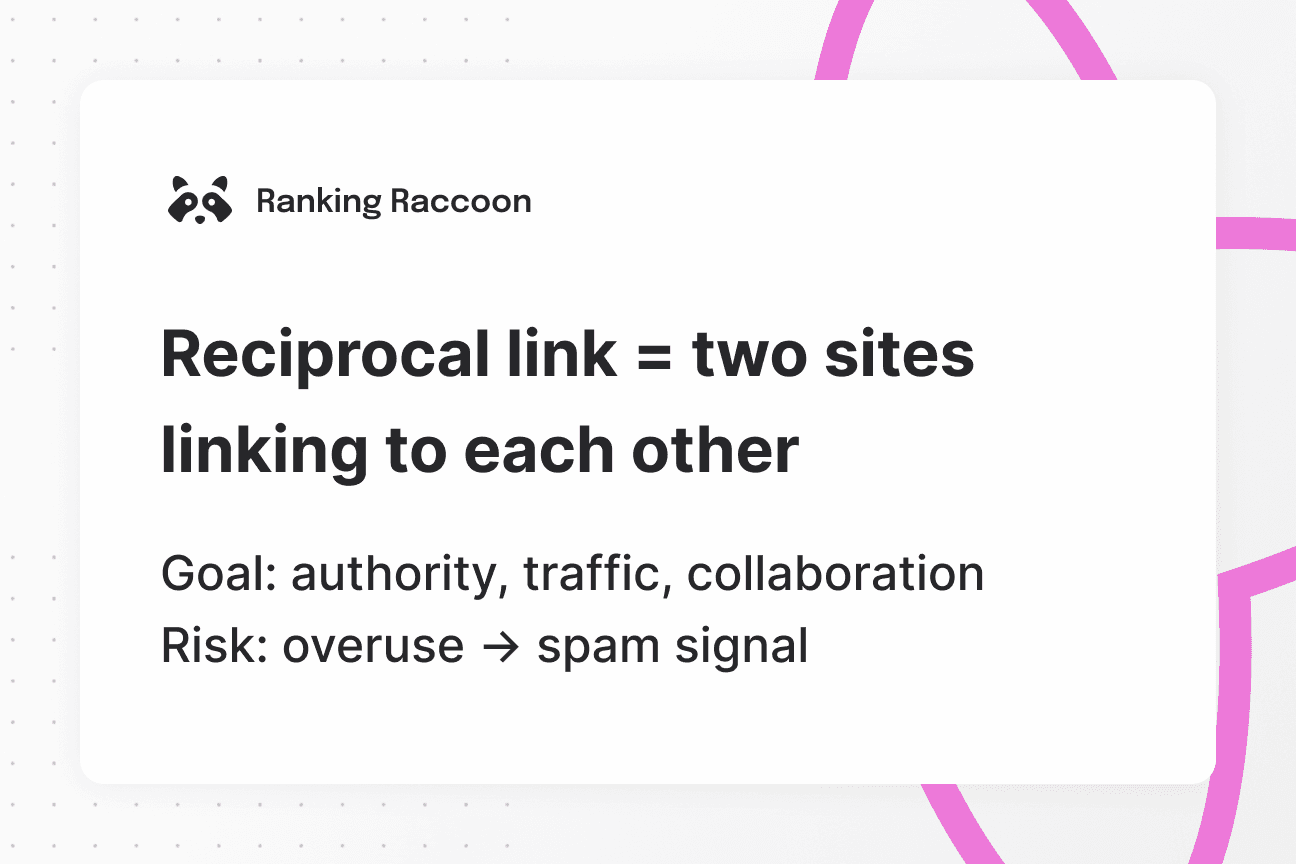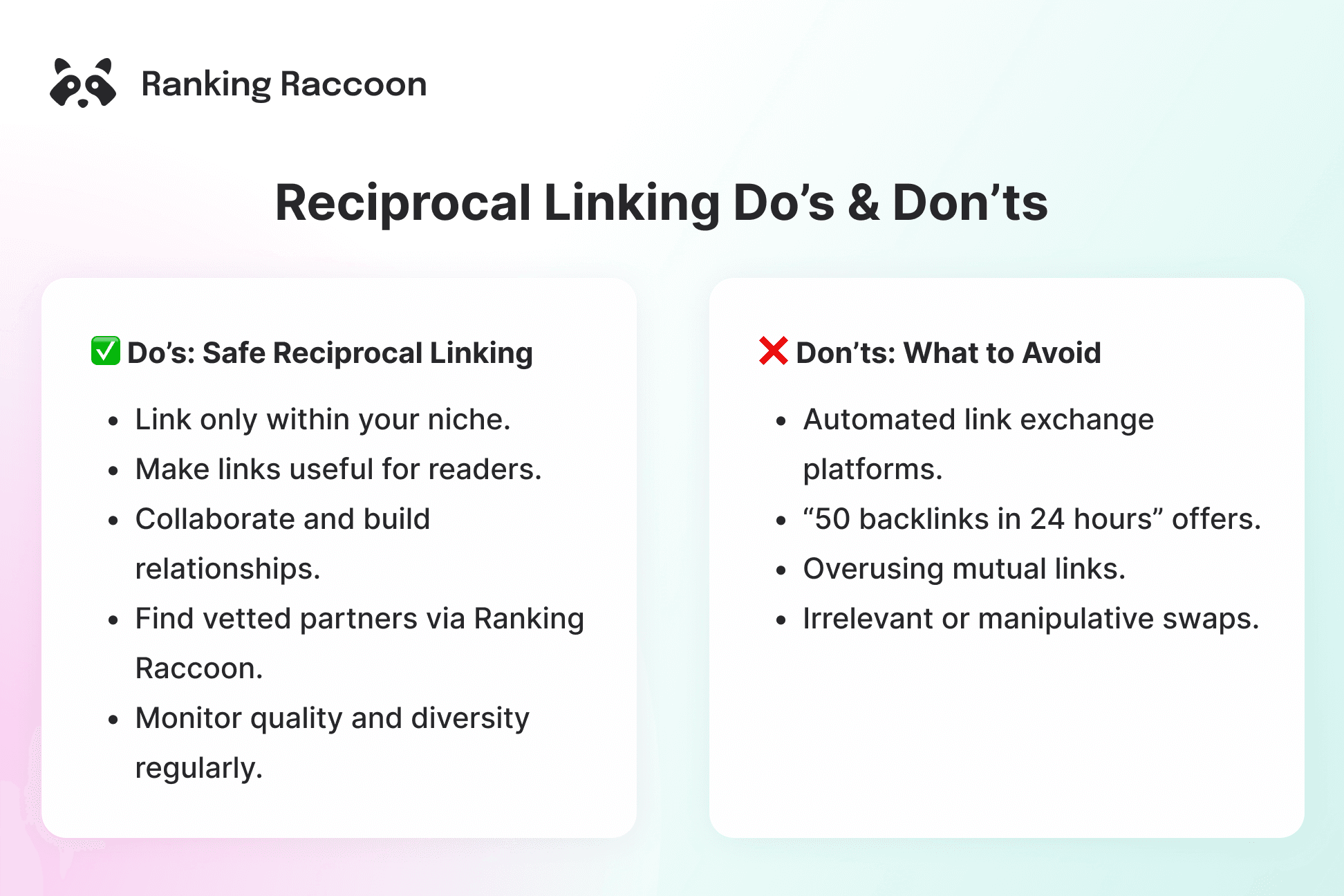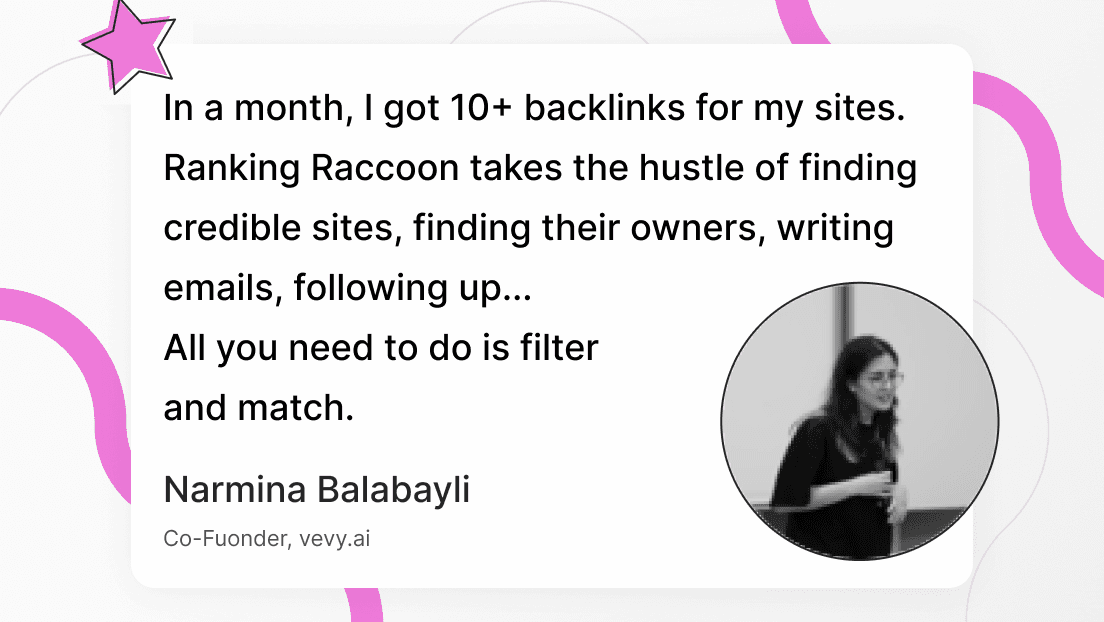What Is a Reciprocal Link? The Truth About Link Swaps in SEO

Eliza Forgacs
“You scratch my back, and I’ll scratch yours”—that’s basically the main principle behind reciprocal links. So if you’ve ever swapped links with another website, you’ve already dabbled in reciprocal linking. But beware; under the simplicity of the definition, complex and nuanced practices determine whether you’re actually helping your website’s rankings—or triggering a penalty from Google.
Understanding how reciprocal links really work in today’s SEO world is crucial. Here’s what you’ll get from reading this article:
- What a reciprocal link actually is
- How reciprocal linking can fit into your SEO strategy
- How to create links safely and effectively with the help of Ranking Raccoon
- More practical tips to avoid penalties and maintain link quality

What Is a Reciprocal Link in SEO?
It’s kind of a telling name, so the original meaning doesn’t require much clarification. Reciprocal linking occurs when two websites mutually link to each other; site A links to site B and site B links back to site A.
Yeah, but where is the catch?
The pitfall lies in today’s more advanced Google algorithms and AI-driven spam detection. There is a fine line between natural reciprocity, strategic link swaps, and straight manipulation. Basically, it means that not every mutual link is a good link.
According to Ahrefs, who studied almost 150K domains with at least 10K monthly visitors, over 73.6% of them had some reciprocal links. That means link swaps are not uncommon—they exist quite widely.
How come that in some cases, mutually linking to each other’s content is totally fine in Google’s eyes and sometimes it gets flagged as part of link schemes? Let’s find out!

How to Do Reciprocal Linking Right?
The idea behind reciprocal link building is simple: two websites agree to link to each other, ideally because it benefits both audiences. It works best when it actually serves the users; so your link should add relevance, value, and knowledge to the reader. For instance, a digital marketing blog linking to a content strategy guide from another reputable site—and vice versa—is a natural example of reciprocal linking done right.
If you are adding links that genuinely help someone discover related, useful information, you’re doing it right—but if that link serves nothing more than just being there to affect your SERP rankings—that's a risk.
How should you implement reciprocal linking into your link building strategy? First of all, reciprocal links can only play a supporting role, they should never be the star of the show. Aim for a healthy backlink profile; diverse, more-or-less natural and contextually relevant.
Think of it as a digital handshake—if it’s a genuine gesture between trusted partners, all good. But if it’s just a performance so Google sees the handshake? That’s when things go sideways. Google is more and more sensitive to that stuff, it hates manipulation. In the latest spam policies, excessive direct link exchanges are marked as spam, which will result in penalties or even de-indexing.
In short: The impact of a reciprocal link in SEO depends entirely on how natural, relevant, and user-focused the connection is. There is nothing wrong with a few contextually relevant link swaps, but keep your backlink profile diverse and healthy.

Best Practices for Safe Reciprocal Linking
Inserting reciprocal linking into your SEO strategy isn’t rocket science, although it's important to proceed carefully. Smart, well-judged decisions can make or break your long-term success. Strengthening your site’s authority and earning meaningful traffic both depend on thoughtful link building, not shortcuts. Because let’s face it: you don’t want to be that site that’s one algorithm update away from vanishing off the SERP.
Here is your checklist; keep these pieces of advice in mind while working on your reciprocal links.
1. Always Prioritize Relevance
To avoid raising red flags, only exchange links with websites that are genuinely connected to your niche. A lifestyle blog linking to a SaaS marketing site? That screams manipulation and Google recognizes when a link looks forced. Keep your exchanges natural, logical, and contextually relevant.
2. Think About The Real-Life Readers
A backlink should always point to something informative, useful, or complementary. Your reciprocal links should add value to the reader's experience, not distract from it. Google’s main goal is user satisfaction—so if your links help users find more useful content, you win both algorithmically and experientially.
3. What to Avoid?
If something sounds too good to be true, it usually is. Stay far away from automated link exchange platforms or anyone promising “50 backlinks in 24 hours.” You need control over where your links go—and where they come from. Also, avoid overusing mutual linking (“I’ll link to you 20 times if you link to me 20 times”). Google’s algorithms will definitely mark that as spam.
4. Focus on Relationships
Collaboration is key to the long-term success of your link building. Connect with site owners, content creators, and businesses whose audience aligns with yours—aim for genuine relationships—link building in 2025 is basically networking.
You can read more about relationship-based link building here: How to Find Your Ideal Link Building Partner?
5. Gain Advantages With Networking Platforms
I’m going to be honest with you: manual outreach is dead. It craves too much time, too much effort, meanwhile offers too little outcome. Average cold email reply rate stagnates around 5%—but platforms like Ranking Raccoon can make your link building journey smoother. It’s a membership-based ecosystem where every user and site is manually vetted, letting only like-minded professionals into the “inner circle.”
6. Monitor, Monitor, Monitor…
Always keep an eye on your backlink profile, it’s not that hard using tools like Ahrefs or Semrush. Look out for link quality, anchor text variety, and broken links. Keep your profile diverse, since reciprocal links are okay here and there, but don’t swap links with the same sites excessively. On one hand, receiving backlinks from one domain over and over again won’t really move the needle, and on the other hand, it can trigger the spam bells of Google.
The Solution for The Link Exchange Dilemma: The ABC Method
It’s clear to you now that reciprocal linking can be a double-edged sword. But how do you keep the benefits without falling into the trap of obvious two-way exchanges?
Well, if you’ve spent any time in the SEO world, you’ve probably heard of the ABC link exchange. It’s essentially a smarter, safer alternative to direct link swaps —and a popular method among marketers who want to build authority without setting off Google’s spam alarms.
So what’s the idea behind it? Instead of two sites linking directly to each other, you add a third one into the mix:
- Site A links to Site B
- Site B links to Site C
- Site C links back to Site A
This creates a more natural pattern, feels organic, and mimics how links actually spread across the web. But remember, it only works if you stay loyal to the core values; relevance and trust. The goal is a small ecosystem of relevant, trustworthy websites that share a niche, values and an audience.
As one SEO specialist put it:
“I've been working with exchanges for almost 2 years now. Yes, they work and they are the best quality, but it depends on what partners it happens to collaborate with.”
And they’re right. Trust and topical alignment are what make the ABC method both effective and future-proof.
In a nutshell: ABC link exchange is a healthier version of link swapping—it creates an organic pattern which avoids the obvious “you link to me, I link to you” footprint. This collaborative ecosystem is based on authentic relationships between sites that support each other.

Building Reciprocal Links With Ranking Raccoon
Finding trustworthy partners to collaborate with can feel like looking for a needle in a haystack. Hours of prospecting, pitching cold emails and getting ignored more than 90% of the time… than ending up with one sad, irrelevant backlink. That’s not how it should be.
It should be easy, clear-cut and fast. That’s exactly the idea behind Ranking Raccoon. We dreamed of a link building platform, where finding link exchange partners with the same goals and values is simple.

Just a few ways Ranking Raccoon saves you from the headache:
- Only manually vetted websites—this way we ensure that you can select from quality sites with a natural backlink profile.
- Search by keyword to instantly find websites open to collaborate and relevant to your niche.
- Let AI do the matchmaking—it automatically recommends the most relevant, high-quality sites for your domain.
- Chat directly in-platform with potential partners—no more endless email chains, ghosting, or awkward outreach scripts.
- And here’s the best part: no paid links, no shady deals. Just one simple membership fee, and you get access to a vetted community of site owners who actually want to collaborate.
Reciprocal links built through Ranking Raccoon are safer, smarter, and faster. If you’re looking for links with real referral value, give it a try. It isn’t just another SEO tool—it’s your reciprocal linking ecosystem, built on trust and transparency.
Want to start building smart reciprocal links today? Try Ranking Raccoon and find vetted partners in minutes.
Whether you’re a blogger, a SaaS startup, or an SEO agency juggling dozens of clients, you’ll find your perfect link building partners faster than a raccoon finds shiny objects in a trash can.
Key Takeaways About Reciprocal Link Building
Link building can feel like walking on eggshells. But remember, reciprocal links aren’t evil, just misunderstood… when done smartly and strategically, they can be your secret weapon in the crowded field of SEO battles. They can definitely increase visibility and drive real traffic—just don’t overuse them.
Here’s the cheat sheet you should keep in mind:
- Reciprocal links = mutual value. A good swap benefits both audiences, not just your rankings.
- Relevance rules. Only link to websites in your niche—Google can smell forced links from a mile away.
- Quality over quantity. A few trustworthy, contextually relevant links beat dozens of random exchanges.
- ABC method > direct swaps. Use triangle-style link exchanges (A → B → C → A) to stay natural and organic.
- Focus on relationships. In 2025, link building is networking. Real connections lead to real backlinks.
- Use the right tools. Platforms like Ranking Raccoon simplify safe, sustainable link-building with vetted partners and zero spam.
- Keep monitoring. Use analytics tools to track link performance, quality, and health—your backlink profile deserves regular checkups.
At the end of the day, reciprocal linking isn’t a shameful, forbidden trick, it’s a collaboration tactic. Treat it with care, stay relevant, and your backlinks will work with you, not against you.
What Is a Reciprocal Link and Other Frequently Asked Questions
1. What is an example of a reciprocal link?
Here is a classic example; Blog A links to Blog B’s article about keyword research, and Blog B links back to Blog A’s guide on SEO trends. It works because both links make sense contextually, serve readers, and therefore strengthen each other’s authority.
2. How do I make a reciprocal link safely?
User experience should be a top priority. If you swap links with websites that share your niche and your contents have topic relevance, it should be fine. Just ensure to genuinely add value to your readers.
3. Are reciprocal links good for SEO?
Yes—and no. When done naturally, they’re a sign of trust and collaboration. But excessive or irrelevant exchanges are flagged as manipulative link schemes and can hurt your rankings.
4. What is a reciprocal site?
A reciprocal site is simply a website that links to yours while you link back to it. The relationship can be healthy and organic if both sites share relevance, authority, and have overlapping audiences.
5. What’s the best way to get reciprocal links today?
If you want to build links in 2025, you can’t escape networking. Use a vetted platform like Ranking Raccoon to find trustworthy partners faster. You can filter sites by relevance, DR number or search for keywords you want to get links from. Reach out to site owners via in-platform chat—believe me, it’s far less awkward than begging strangers for backlinks.
6. How many reciprocal links are “too many”?
There’s no hard number—but if most of your backlinks are from sites that also link to you, that’s a red flag. Keep your profile diverse with natural one-way links, guest posts, and citations. Aim for balance: a few well-chosen mutual links are fine, but they should make up only a small fraction of your total backlinks. If reciprocal links start to dominate, Google may interpret your profile as manipulative rather than organic.
7. Can Google detect ABC link exchanges?
It’s possible, but far less obvious than direct swaps. The ABC method spreads links across a network of relevant sites, mimicking organic web behavior. Still—relevance, trust, and moderation remain your best defense. Think of it as creating a natural web of value: every link should serve a purpose, connect related topics, and feel authentic to readers. When done right, ABC linking strengthens your site’s authority without setting off any algorithmic alarms.

Eliza Forgacs
Marketing Manager